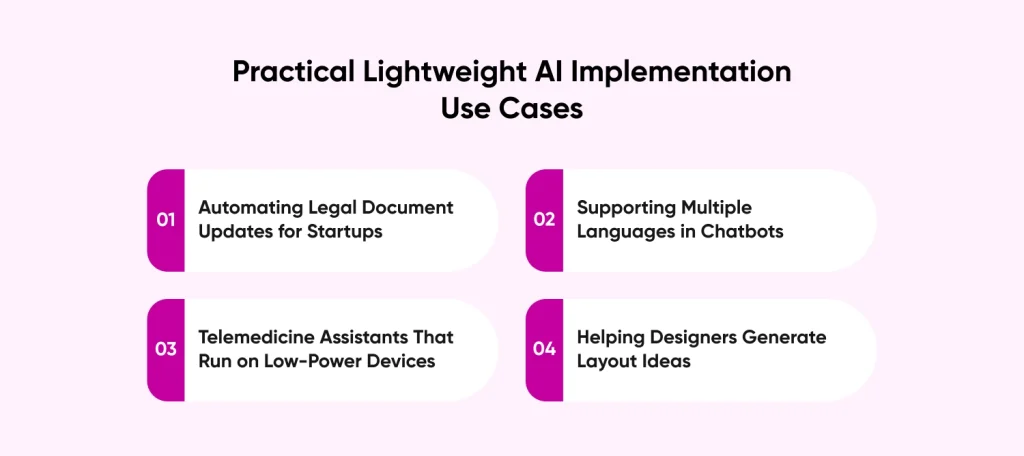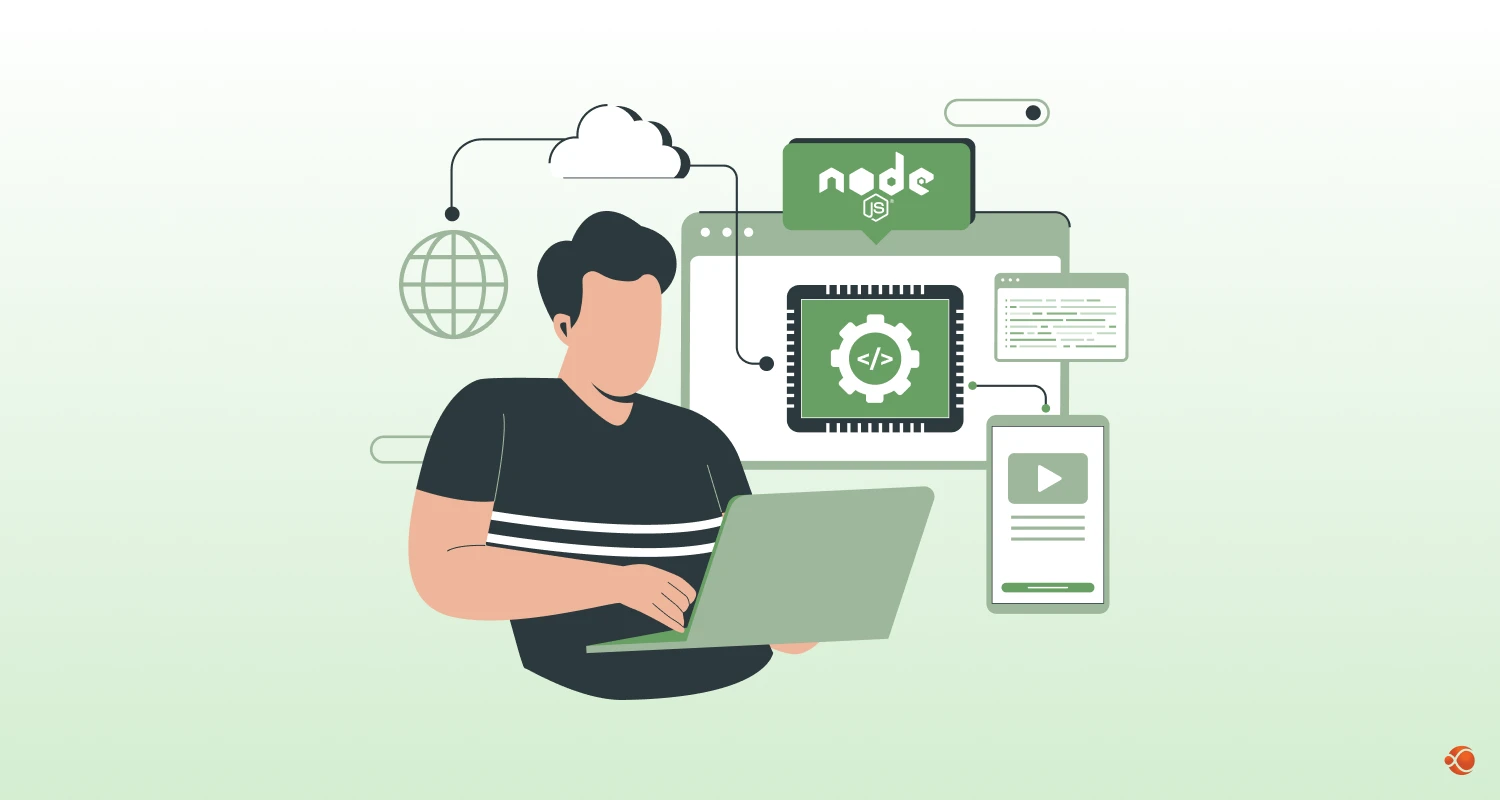In the constantly evolving field of AI, startups are constantly striving to stay competitive. But while large corporations can afford to train and run massive models like GPT-4 or BERT, startups often face limitations in terms of budget, compute alternatives that are cost-efficient, resource-friendly, and capable of delivering real-world results.
Techniques such as LoRA (Low-Rank Adaptation), PEFT (Parameter-Efficient Fine-Tuning), quantization, model pruning, and knowledge distillation have emerged as game-changers for startups that want to innovate without burning through capital. We dive deep into these lightweight AI techniques and methods, explaining how each one works and why every startup should consider integrating them into their AI strategy.
Why Lightweight AI Matters for Startups?
Startups typically operate under intense pressure to innovate quickly, launch products fast, and scale efficiently—all while managing costs. Deploying standard AI models can be incredibly resource-intensive, making them impractical for most early-stage companies.
Lightweight AI techniques enable startups to:
- Leverage pre-trained models without starting from scratch
- Reduce training and inference costs
- Deploy AI on edge devices and mobile hardware
- Adapt models quickly to new tasks or domains
What is PEFT (Parameter-Efficient Fine-Tuning)?
PEFT allows for the AI model fine-tuning development of large language models by modifying only a small subset of parameters, while keeping the rest of the model frozen. This drastically reduces training time, GPU/TPU usage, and the overall cost of experimentation.
Advantages of PEFT for Startups
- Lower compute requirements: Train on consumer-grade hardware or cheaper cloud instances.
- Rapid iteration: Fine-tune quickly for different clients or industries.
- Modularity: Keep a shared base model and fine-tune different adapters for specific tasks.
PEFT is particularly useful for NLP applications such as chatbots, classification, summarization, and translation, where a base model like BERT or LLaMA can be adapted with minimal additional training.
What is LoRA (Low-Rank Adaptation)?
LoRA is one of the most effective PEFT techniques. Instead of updating entire weight matrices during AI model fine-tuning, LoRA inserts low-rank decomposition matrices into the network. This allows for backpropagation through much smaller parameter sets.
How LoRA Works?
In deep learning, weight matrices are often high-dimensional. LoRA approximates these with two smaller matrices:
- A (low-rank representation)
- B (expansion back to original shape)
Only these matrices are updated during training, while the base model remains untouched. This makes it possible to fine-tune massive models like LLaMA or GPT using just a few million parameters.
Use Cases for LoRA
- Chatbots with domain-specific vocabulary
- Build train ai models for Customer service
- Healthcare or legal NLP systems requiring specialization
Startups can save up to 90% of training costs using LoRA compared to full fine-tuning.
Quantization: Shrinking Models Without Losing Intelligence
Quantization reduces the numerical precision of a model’s parameters, typically from float32 to int8 or float16. While this may sound minor, it results in dramatic improvements in performance and resource efficiency.
Key Benefits of Quantization
- Smaller model sizes: Easier to deploy on mobile or edge devices.
- Faster inference: Ideal for real-time applications.
- Lower memory consumption: Reduces RAM/VRAM needs.
Partner with AI software development services that are proficient with tools like Hugging Face’s BitsAndBytes, ONNX Runtime, and TensorRT, quantization can be applied post-training or during training, depending on the framework.
When to Use Quantization?
- Deploying models on smartphones, IoT, or embedded devices
- Serving AI APIs at high volume and low latency
- Optimizing inference performance without retraining
Startups working on AI-powered apps, wearables, and embedded systems should prioritize quantization early in their development process.
Pruning: Remove the Dead Weight
Model pruning refers to the removal of unnecessary or low-impact neurons, weights, or even entire layers from a neural network. By eliminating redundancy, startups can run leaner models that perform just as well.
Types of Pruning
- Unstructured pruning: Removes individual weights based on magnitude.
- Structured pruning: Removes entire channels, neurons, or blocks.
- Dynamic pruning: Adjusts pruning during inference based on input.
Advantages for Startups
- Improved inference speed
- Smaller model size
- Reduced power consumption
Pruning is especially useful for computer vision models, speech recognition, and time-series forecasting on resource-constrained devices.

Knowledge Distillation: Teach Small Models Big Ideas
In knowledge distillation, a large, pre-trained model (the teacher) trains a smaller model (the student) by mimicking its behavior rather than just replicating label outputs.
How Distillation Helps
- The student learns not just the “correct” answer but soft labels that reflect model confidence.
- It captures nuances in the teacher’s decision boundaries.
- Results in smaller, faster models that retain most of the teacher’s performance.
Distillation in Practice
- BERT → DistilBERT
- GPT → DistilGPT
- T5 → TinyT5
These distilled models are 50–60% smaller and up to 2x faster, making them ideal for startups deploying NLP solutions.
Transfer Learning and Weight Sharing
Beyond individual techniques, startups can leverage transfer learning by reusing pre-trained models for different tasks. Using weight sharing, common components of the network can be reused across multiple objectives.
Why This Matters
- Accelerates development across multiple features.
- Reduces redundant computation and model duplication.
- Encourages modular architecture, which scales better.
This is especially powerful in multi-task learning environments, such as analytics dashboards, voice assistants, or intelligent automation tools.
Choosing the Right Lightweight AI Approach
Not every technique suits every use case. Here’s a decision guide to help startups choose:
| Business Need | Recommended Technique |
| Fast time-to-market with limited compute | LoRA, PEFT |
| Mobile or edge deployment | Quantization, Pruning |
| Real-time predictions on limited hardware | Distillation, Quantization |
| Reusable architecture for multi-products | Transfer Learning, Weight Sharing |
Top Tools and Frameworks for Lightweight AI
Hire ai developers that make use of top lightweight AI tools:
- Hugging Face Transformers + PEFT/LoRA
- BitsAndBytes (for quantization)
- ONNX Runtime – For deploying optimized models cross-platform
- TensorRT – Nvidia’s inference optimizer
- OpenVINO – Intel’s toolkit for CPU/edge optimization
- DeepSpeed – Microsoft’s tool for efficient model training
- PyTorch Lightning – Simplified, scalable model training
These frameworks make it easy for teams to build, fine-tune, and deploy optimized models. You can also build lightweight services in asp.net core 6.
Practical Lightweight AI Implementation Use Cases

1. Automating Legal Document Updates for Startups
Startups in the legal tech space have to process and summarize thousands of legal documents like contracts, privacy policies, and compliance notices. Instead of retraining a full-scale language model, lightweight AI techniques such as LoRA allow these startups to make tiny, efficient updates to pre-trained legal models.
With LoRA, they are able to modify the model to new regulations like GDPR updates or region-specific compliance laws without needing massive computing resources. This allows even small teams to stay agile and accurate in a fast-changing legal landscape.
2. Supporting Multiple Languages in Chatbots
Many startups want to scale their customer service to different countries, but training a separate chatbot model for each language can be expensive. With PEFT, they can use a single base language model and fine-tune it for each language using small sets of parameters. For instance, a startup can adapt a chatbot to handle Spanish, Hindi, or Arabic using LoRA or adapter modules. This way, they only fine-tune what’s necessary for each language, making the model faster to train and easier to deploy, even with limited infrastructure.
3. Telemedicine Assistants That Run on Low-Power Devices
Healthcare startups providing telemedicine services often want AI systems that can help doctors and patients describe symptoms, suggest possible conditions, and flag emergencies. Using a full model for this would typically require expensive servers. But with QLoRA—a quantized version of LoRA—they can shrink the model down to run on mobile phones or low-end laptops. This enables basic AI features like symptom checkers to run even in remote areas with weak internet or on older devices, making digital healthcare more accessible.
4. Helping Designers Generate Layout Ideas
In the design world, startups building creative tools want to allow users to describe a screen in words and generate UI mockups. This needs vision-language models, which are often large and complex. Instead of retraining the whole model, startups can use LoRA to fine-tune it specifically for UI elements like buttons, grids, and menus. This saves time and makes it possible to run these models directly inside design software, giving users instant AI feedback without needing constant internet access or GPU support.
Common Pitfalls to Avoid
- Over-pruning or excessive quantization can harm model accuracy.
- Neglecting cross-platform testing may result in poor performance on mobile.
- Relying solely on open data.
- Skipping validation benchmarks leads to poorly performing lightweight AIdeployments
Conclusion: Lightweight AI is the Future for Startups
AI started off as monolithic giant software and tools for carrying out complex interactions. However, the innovative path to AI in today’s time doesn’t need to go through monolithic models. We can easily adopt efficient, scalable and modular AI techniques.
Whether you’re building a mobile app, a SaaS product, or an intelligent automation platform, lightweight AI methods like LoRA, PEFT, quantization, pruning, and distillation can make your vision both affordable and powerful.
Don’t let resource limitations stall your AI journey. With the right strategy, even small teams can build world-class AI.
Frequently Asked Questions
What Is Lightweight AI and Why Is It Important for Startups?
Lightweight AI refers to simplified, resource-efficient AI models that require minimal computational power and memory. For startups, it’s crucial because it enables AI implementation without expensive infrastructure investments, reduces operational costs, accelerates development cycles, and allows rapid prototyping with limited technical resources and budgets.
Which Industries Benefit Most From Lightweight AI Approaches?
Healthcare (diagnostic tools), retail (recommendation systems), fintech (fraud detection), manufacturing (predictive maintenance), agriculture (crop monitoring), and mobile app development benefit most. These industries need cost-effective, deployable AI solutions that can run on edge devices or with limited cloud resources while maintaining acceptable performance.
What Are the Benefits of Using Lightweight AI Models for Startups?
Key benefits include dramatically lower computational costs, faster inference times, easier deployment across devices, reduced infrastructure requirements, quicker iteration cycles, lower barrier to entry, improved scalability, and the ability to run AI applications locally without constant internet connectivity or expensive cloud services.
Can LoRA and PEFT Be Used With Large Language Models Like GPT?
Yes, LoRA (Low-Rank Adaptation) and PEFT (Parameter-Efficient Fine-Tuning) techniques can be applied to large language models including GPT variants. These methods allow fine-tuning with minimal additional parameters, significantly reducing computational requirements while maintaining model performance for specific tasks and use cases.







